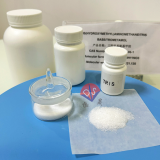Chinese VersionChina Suppliers > Hubei new DE sheng material science and technology co., LTD. > The role of Tris in activated carbon filtration
- Search Product
-
-
- Region :China/Hubei
- Tel : +86-18971041571
- Fax :
- Email :vickyzhao@whdschem.com
- URL :
- Add :Guanggu United Science and Technology City C8, Ezhou City, Hubei Province
- Details for The role of Tris in activated carbon filtration
-
The role of Tris in activated carbon filtration
Category : Other Chemicals/Others

CAS NO : 77-86-1 EC NO : 201-064-4 MF : C4H11NO3 MW : 121.14 Specification : White Powder Packing : 500g/bottle Product description : Activated carbon is an efficient and environmentally friendly filtering material widely used in various liquid and gas phase filtration processes. Tris can play an important role in the filtration process of activated carbon. This article will provide a detailed introduction to the role and principle of Tris in activated carbon filtration. 1、 Characteristics of Tris Tris, also known as trimethylaminomethane, is a colorless crystal that is easily soluble in water. It has a lower melting and boiling point, and is stable at high temperatures, making it an ideal filtering additive. The role of Tris in activated carbon filtration 1. Improve the adsorption performance of activated carbon Tris can interact with activated carbon, changing its surface polarity and hydrophilicity, thereby improving its adsorption capacity for certain pollutants. Research has shown that Tris can effectively improve the adsorption efficiency of activated carbon for organic matter, heavy metals, and microorganisms. 2. Enhance the pollution resistance of activated carbon Tris can adsorb on the surface of activated carbon, forming a protective film to prevent further contact between pollutants and activated carbon. This not only reduces the blockage of pollutants in the pores of activated carbon, but also reduces the loss and waste of activated carbon. 3. Promote the desorption and recovery of pollutants Tris can desorb pollutants adsorbed on the surface of activated carbon through methods such as complexation, ion exchange, or chemical reactions. This process helps to improve the regeneration efficiency of activated carbon and extend its service life. Meanwhile, the desorbed pollutants can be further separated and purified for recycling and reuse. Uses : Biological buffer Synonyms : 2-Amino-2-hydroxymethyl-1,3-propanediol;TRIS;Tromethamine;Tromethane;tris(hydroxyme.)aminomethane;trizma base;Trometamol;tri(hydroxymethyl)methylamine;Tris(hydroxymethyl) methylamine Tris buffer 99.8+ %;Trihydroxymethyl Aminomethane;Tris, Ultra Pure;Tris, Tissue Culture Tested Tris(hydroxymethyl)aminomethane, Tissue Culture Tested;Tris, Alcohol Free Tris(hydroxymethyl)aminomethane, Alcohol Free;Tris(hydroxymethyl)aminomethane, Ultra Pure, Molecular Biology Grade;Tris EDTA acetate buffer;THAM;Trimethanolaminomethane;Tri(hydroxymethyl)aminomethane;Tris(hydroxymethyl)aminomethane;2-Amino-2-(hydroxymethyl)-1,3-propanediol;Tris hydroxyl methyl amino methane;2-amino-2-(hydroxymethyl)propane-1,3-diol;1,3-dihydroxy-2-(hydroxymethyl)propan-2-aminium;(methylamino)methanetriol;Tris(hydroxymethyl) aminomethane;Tris(hydroxymethyl)amino methane;Tris Base; Molecular Structure : 
- more>>Other Products
-
- • Biological buffer 3- [N, N-di (hydroxyethyl) amino] -2-hydroxypropanesulfonic acid DIPSO
- • Luminol Sodium Salt
- • 4-Aminophthalhydrazide
- • acridinium ester DMAE-NHS
- • acridinium ester NSP-DMAE-NHS
- • Acridine hydrochloride NSP-SA
- • Acridine hydrochloride NSP-SA-NHS
- • NSP-SA-ADH
- • acridinium ester ME-DMAE-NHS TOOS; 3-(N-Ethyl-3-Methylanilino)-2-Hydroxypropanesulfonic Acid Sodium Salt
- • TOPS; Sodium 3-(N-Ethyl-3-Methylanilino)Propanesulfonate; N-Ethyl-N-Sulfopropyl-M-Toluidine Sodium Salt
- • ADOS Sodium 3-(Ethyl(3-Methoxyphenyl)Amino)-2-Hydroxypropane-1-Sulfonate Dihydrate
- • ADPS N-Ethyl-N-(3-Sulfopropyl)-3-Methoxyaniline Sodium Salt
- • ALPS N-Ethyl-N-(3-Sulfopropyl)Aniline Sodium Salt; Sodium 3-(Ethyl(Phenyl)Amino)Propane-1-Sulfonate; Sodium
- • DAOS; Sodium 3-((3,5-Dimethoxyphenyl)(Ethyl)Amino)-2-Hydroxypropane-1-Sulfonate
- • HDAOS; N-(2-Hydroxy-3-Sulfopropyl)-3,5-Dimethoxyaniline Sodium Salt
- • MADB N,N-Bis(4-Sulfobutyl)-3,5-Dimethylaniline Disodium Salt
- • MAOS N-Ethyl-N-(2-Hydroxy-3-Sulfopropyl)-3,5-Dimethylaniline Sodium Salt Monohydrate
- • DAB 3,3',4,4'-Biphenyltetramine Tetrahydrochloride